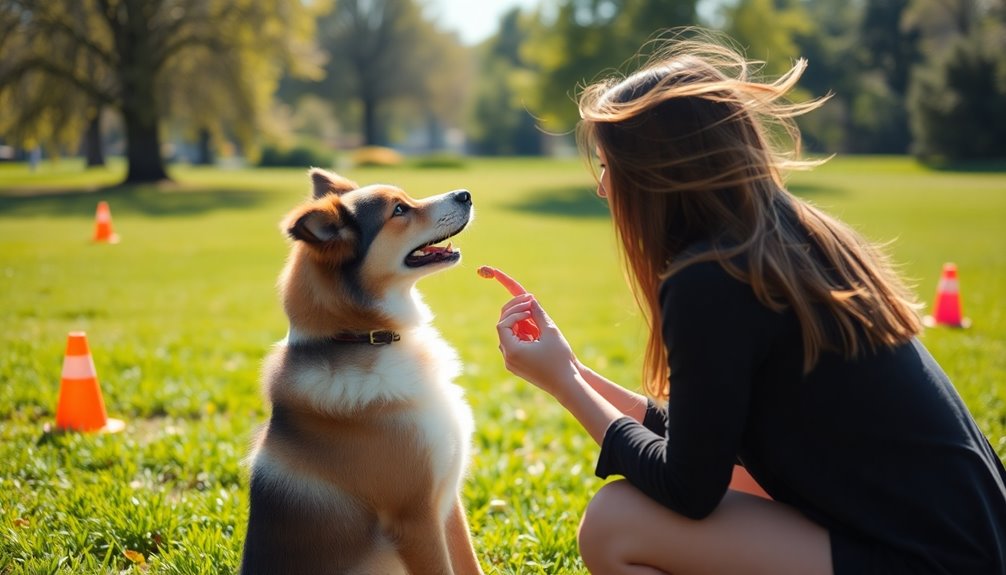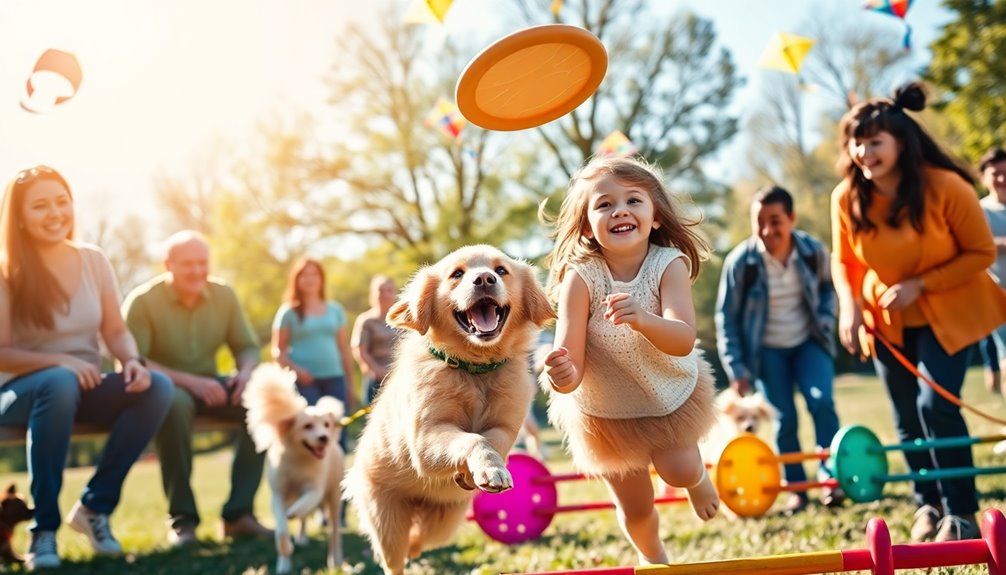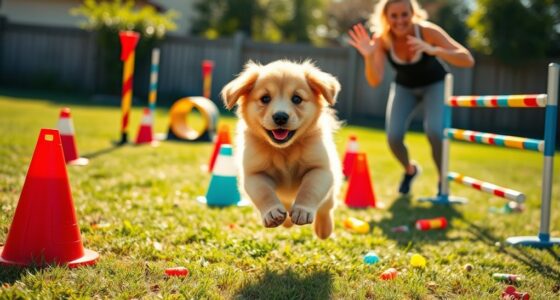To build a stronger bond with your dog through training, focus on creating positive experiences together. Use positive reinforcement to encourage good behavior, reinforcing trust and connection. Keep sessions short and fun to maintain your dog's attention. Incorporate everyday activities into training, like practicing commands during meals. Setting a comfortable environment reduces stress and helps your dog feel secure. Engage in enjoyable activities, such as hide and seek or agility courses, to strengthen your emotional connection. By integrating these approaches, you'll foster deeper relationships and meaningful interactions. There's even more you can explore to enhance your training journey.
Key Takeaways
- Engage in positive reinforcement training to create joyful associations and strengthen trust between you and your dog.
- Tailor training methods to your dog's personality, ensuring a more effective and enjoyable learning experience.
- Incorporate fun activities, like agility courses or hide and seek, to enhance bonding and mental stimulation.
- Maintain a consistent training routine in a comfortable environment to foster security and readiness for learning.
- Use everyday moments, like meal times, as opportunities for training to reinforce commands and deepen your connection.
Benefits of Training for Bonding

Training your dog offers numerous benefits that greatly enhance the bond between you and your furry friend. When you engage in regular training sessions, you create opportunities for meaningful interactions that foster better communication and trust. This connection not only leads to a more responsive pet but also strengthens your bond with your dog.
Using positive reinforcement during dog training helps your furry companion associate your presence with joy and rewards, making them more enthusiastic to engage. These training sessions provide essential mental enrichment, which is crucial for their overall well-being. By focusing on good behavior with positive reinforcement, you can effectively curb unwanted behaviors while promoting a sense of security for your dog.
Additionally, consistent training routines offer physical stimulation, keeping your dog active and healthy. As you work together, you'll notice a deeper emotional connection forming.
Ultimately, the time spent on training not only helps your dog learn but also enhances your relationship, making both of you happier. By investing in training, you're laying the foundation for a lifetime of companionship and trust that will benefit you both.
Effective Training Techniques

When you focus on effective training techniques, you'll find that your dog learns more quickly and enjoys the process. Using positive reinforcement, like treats and praise, encourages desired behaviors and fosters a healthier bond between you and your dog.
Tailor your training methods to fit your dog's unique personality and learning style, ensuring that what you're teaching resonates with them for better results. Consistency is key. Use the same commands and rewards consistently to help your dog understand expectations and reinforce good behavior over time.
Engage in short training sessions to boost retention and maintain your dog's attention, preventing boredom and promoting a positive learning experience. Don't overlook everyday opportunities for training. Every interaction can serve as a chance for growth, whether it's practicing basic commands during walks or rewarding good behavior at home.
Creating a Positive Learning Environment

A positive learning environment is essential for your dog's success and enjoyment during training sessions. When you create a comfortable and familiar space, your dogs can focus better and feel less stressed, leading to improved learning outcomes.
Establishing a consistent training routine helps them understand what to expect, fostering a sense of security and readiness to engage.
During training, it's vital to monitor your dogs for signs of stress or distraction. If you notice any, take a step back to maintain that positive atmosphere.
Use visual cues and reminders to reinforce expectations and keep sessions structured. This not only helps your dog stay focused but also makes the training process more effective.
Fun Activities to Strengthen Connection

Engaging in fun activities with your dog not only strengthens your bond but also enhances your training experience. These moments create positive outcomes for both of you, making dog training more enjoyable and effective.
By incorporating playtime into your routines, you're not just teaching your dog; you're also rewarding your dog for their efforts. Here are three fun activities to engage in:
- Hide and Seek: This classic game challenges your dog's problem-solving skills and provides mental stimulation while you enjoy quality time together.
- Agility Courses: Set up a simple agility course in your backyard. It'll encourage your dog to think critically and build confidence, all while reinforcing your strong bond.
- Puzzle Toys: These toys require your dog to figure out how to access treats inside. It keeps them entertained and promotes cognitive engagement, making training sessions more rewarding. Incorporating hands-on learning through these activities can further enhance your dog's understanding and responsiveness.
Regularly participating in these fun activities helps deepen your emotional connection.
Real-Life Applications of Training

Incorporating training into your dog's daily life transforms ordinary moments into valuable learning experiences. As a dog owner, you can train your dog during everyday activities, making sure every moment counts. For example, use every meal as an opportunity to practice commands. This builds consistency and reinforces good behavior with positive outcomes.
Engaging in real-life applications like teaching your dog to retrieve items or perform tricks during family gatherings enhances their skills while fostering shared experiences. These moments not only bring joy but also strengthen your bond.
Remember, dogs thrive on routine; integrating training into daily life helps them feel secure and confident. Use positive reinforcement to reward your dog for good behavior, such as calmly meeting other pets or people. This solidifies desired behaviors in various environments and builds a strong foundation of trust.
Keep these tips and tricks in mind: every moment shared can be a training moment. By using everyday activities to reinforce commands and manners, you enhance your dog's responsiveness. Ultimately, these consistent interactions lead to a more harmonious relationship that benefits both you and your furry friend.
Frequently Asked Questions
How Do I Build a Stronger Bond With My Dog?
To build a stronger bond with your dog, spend quality time together engaging in activities you both enjoy.
Play fetch, go for walks, or simply relax together.
Pay attention to your dog's body language; it'll help you understand their feelings.
Use positive reinforcement during training to create joyful experiences.
Consistency and clear routines will make your dog feel secure, fostering trust and a deeper connection between you both.
Trust grows with every shared moment!
What Is Bonding Training?
Think of bonding training like weaving a tapestry, where each thread represents a shared experience between you and your dog.
It's about creating a deep emotional connection through activities like feeding, training, and play.
You'll engage in positive interactions, read your dog's body language, and establish routines that foster trust.
How Long Does It Take to Fully Bond With a Dog?
Bonding with your dog can take anywhere from a few weeks to several months. It largely depends on your dog's temperament, past experiences, and how consistently you interact with them.
Factors like age, breed, and previous socialization also play a role. If you've rescued a dog or one with a history of trauma, be prepared for it to take longer.
Patience and understanding are key to developing a strong, trusting relationship.
How Do I Rebuild My Bond With My Dog?
To rebuild your bond with your dog, start by spending quality time together.
Engage in fun activities like walks or playtime, and incorporate training sessions to reinforce your connection.
Use positive reinforcement to encourage good behavior, and be consistent with your commands.
Pay close attention to your dog's body language and emotions—understanding their needs is key.
With patience and dedication, you'll strengthen the trust and love between you both.
Conclusion
Incorporating training into your routine can transform your relationship into something truly special. As you both learn and grow together, you'll discover unexpected moments of joy and connection, like that time you both laughed at a silly mistake during a session. So, embrace the process and watch your bond strengthen in ways you never imagined. With every shared success and challenge, you're not just training; you're building memories that last a lifetime.










